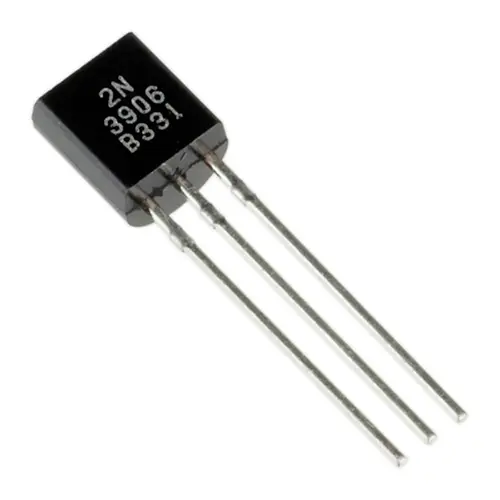It has a DC gain (hFE) ranging from 110 to 300, which determines its amplification capability. The maximum continuous collector current is 200mA, so it should not be used to drive loads exceeding this current. To properly bias the transistor, the base current (IB) should be limited to 5mA. When fully biased (saturation region), it allows up to 200mA current between collector and emitter.
In saturation, the typical voltages are 40V across the collector-emitter (VCE) and 5V across the base-emitter (VBE). When the base current is removed (cut-off region), the transistor turns fully off, with a base-emitter voltage around 5V.
Features
- Bipolar PNP Transistor
- DC Current Gain (hFE): up to 300
- Continuous Collector Current (IC): 200mA
- Emitter-Base Voltage (VBE): 5V
- Base Current (IB): max 5mA
- Collector-Emitter Voltage (VCE): 40V
- Collector-Base Voltage (VCB): 40V
- Available in TO-92 package
Where to Use 2N3906
The 2N3906 is commonly used for switching high-voltage loads up to 0.2A. It is similar to the BC557 transistor but can handle higher collector-emitter voltages. Due to its limited gain, it is not recommended for amplifier circuits. If you need a PNP transistor to switch moderate high-voltage loads within 200mA, the 2N3906 is a suitable choice.
How to Use 2N3906
The 2N3906 transistor is typically used as a switch operating in saturation (fully ON) and cut-off (fully OFF) regions. For a PNP transistor, the device is ON when the base is grounded (reverse biased) and OFF when a positive voltage is applied to the base. A resistor is usually placed in series with the base pin to limit current and protect the transistor.
It has a DC gain (hFE) ranging from 110 to 300, which determines its amplification capability. The maximum continuous collector current is 200mA, so it should not be used to drive loads exceeding this current. To properly bias the transistor, the base current (IB) should be limited to 5mA. When fully biased (saturation region), it allows up to 200mA current between collector and emitter.
In saturation, the typical voltages are 40V across the collector-emitter (VCE) and 5V across the base-emitter (VBE). When the base current is removed (cut-off region), the transistor turns fully off, with a base-emitter voltage around 5V.
Features
- Bipolar PNP Transistor
- DC Current Gain (hFE): up to 300
- Continuous Collector Current (IC): 200mA
- Emitter-Base Voltage (VBE): 5V
- Base Current (IB): max 5mA
- Collector-Emitter Voltage (VCE): 40V
- Collector-Base Voltage (VCB): 40V
- Available in TO-92 package
Where to Use 2N3906
The 2N3906 is commonly used for switching high-voltage loads up to 0.2A. It is similar to the BC557 transistor but can handle higher collector-emitter voltages. Due to its limited gain, it is not recommended for amplifier circuits. If you need a PNP transistor to switch moderate high-voltage loads within 200mA, the 2N3906 is a suitable choice.
How to Use 2N3906
The 2N3906 transistor is typically used as a switch operating in saturation (fully ON) and cut-off (fully OFF) regions. For a PNP transistor, the device is ON when the base is grounded (reverse biased) and OFF when a positive voltage is applied to the base. A resistor is usually placed in series with the base pin to limit current and protect the transistor.
